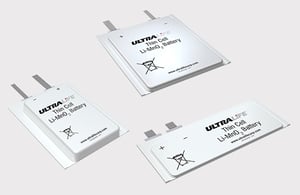 Films about fictitious shrinking devices - like Honey, I Shrunk the Kids and Despicable Me - have captured the imagination of audiences for many years. So imagine the excitement in 2011 when Chinese engineers claimed to have made the world’s first shrinking device. While it may sound like it came from a film, the device only created the illusion of a smaller object, rather than actually shrinking it.
Films about fictitious shrinking devices - like Honey, I Shrunk the Kids and Despicable Me - have captured the imagination of audiences for many years. So imagine the excitement in 2011 when Chinese engineers claimed to have made the world’s first shrinking device. While it may sound like it came from a film, the device only created the illusion of a smaller object, rather than actually shrinking it.
Illusions aside, devices in the electronics sector are continuing to get smaller and, therefore, the batteries needed to power them must be equally compact. That is why, around the same time as the Chinese engineers were working on their device, Ultralife began manufacturing Thin Cell® batteries that would be among the smallest batteries available on the market. Despite their small size, Thin Cells® can provide a stable voltage to power electronic devices and outperform coin cells at higher discharge rates.
So, what makes Thin Cells® different from other types of batteries on the market?
The chemistry behind Thin Cell® batteries originated over twenty years ago when Ultralife developed the 9-volt battery.
 Over the years of developing one of the most successful batteries on the market, Ultralife’s engineers changed the cell layout to maximize the space used. The original cylindrical cells wasted vital space by using a square formation, so the Thin Cell® battery was developed as a pouch with square cells. It was also necessary to keep moisture out of the cell, so Ultralife’s engineers sealed the cell with a bespoke mixture of materials to ensure battery longevity.
Over the years of developing one of the most successful batteries on the market, Ultralife’s engineers changed the cell layout to maximize the space used. The original cylindrical cells wasted vital space by using a square formation, so the Thin Cell® battery was developed as a pouch with square cells. It was also necessary to keep moisture out of the cell, so Ultralife’s engineers sealed the cell with a bespoke mixture of materials to ensure battery longevity.
Because of this longevity and the small size of the battery, the Thin Cell® battery is having an impact on a few different industries, allowing engineers to make devices smaller, yet just as effective.
Asset Tracking
For example, asset tracking is becoming increasingly sophisticated and is better able to protect items because of the development of Thin Cell® batteries.
On construction sites, large quantities of materials are delivered and received every day, with vehicles and people moving in and out of the sites regularly. This makes them a prime target for the theft of valuable metals such as copper. Using Thin Cell® batteries in small trackers attached to the valuable materials is a much more efficient way than using RFID tags, which must be manually scanned. Because the batteries are small, the tracker can be fitted discreetly to deter thieves from breaking off the tag.
For the forgetful among us, companies are now offering Bluetooth tracking tags to consumers to keep an eye on where they have left their keys or wallet. By using Thin Cell® batteries, the tags are small enough to attach to everyday devices without adding additional bulk, but also have a high energy density to ensure that the consumer does not need to replace the battery as frequently.
Monitoring in smart homes and in health
The safety and security sector is also benefiting from increasingly small batteries, which are vital to the continued development of smart devices. In 2020, it was estimated that consumers would spend $19.4 billion on security systems, with smart locks among the best-selling products. Using Thin Cell® batteries, smaller sensors for these devices can be manufactured. These can be easily hidden around the house, so that burglars do not simply see the sensors, avoid them or destroy them.
The Medtech sector is another growing market where thinner and smaller batteries make patient monitoring easier. Juxtaposed alongside the growing medical wearables market, Thin Cell® batteries reduce the size of components in the wearable device. This makes them more comfortable to wear for long periods of time and means they do not interfere with movement.
These sectors are only a selection of those where the use of Thin Cell® batteries has made devices smaller, while not compromising on a reliable power source. With more sectors taking heed of the Internet of Things (IoT), the industry trend for connected devices, the demand for smaller components will increase.
While we might not be seeing a shrinking device any time soon, the IoT means that device manufacturers are increasingly looking for smaller, yet reliable components, meaning they must rely on the expertise of experienced and innovative companies.


